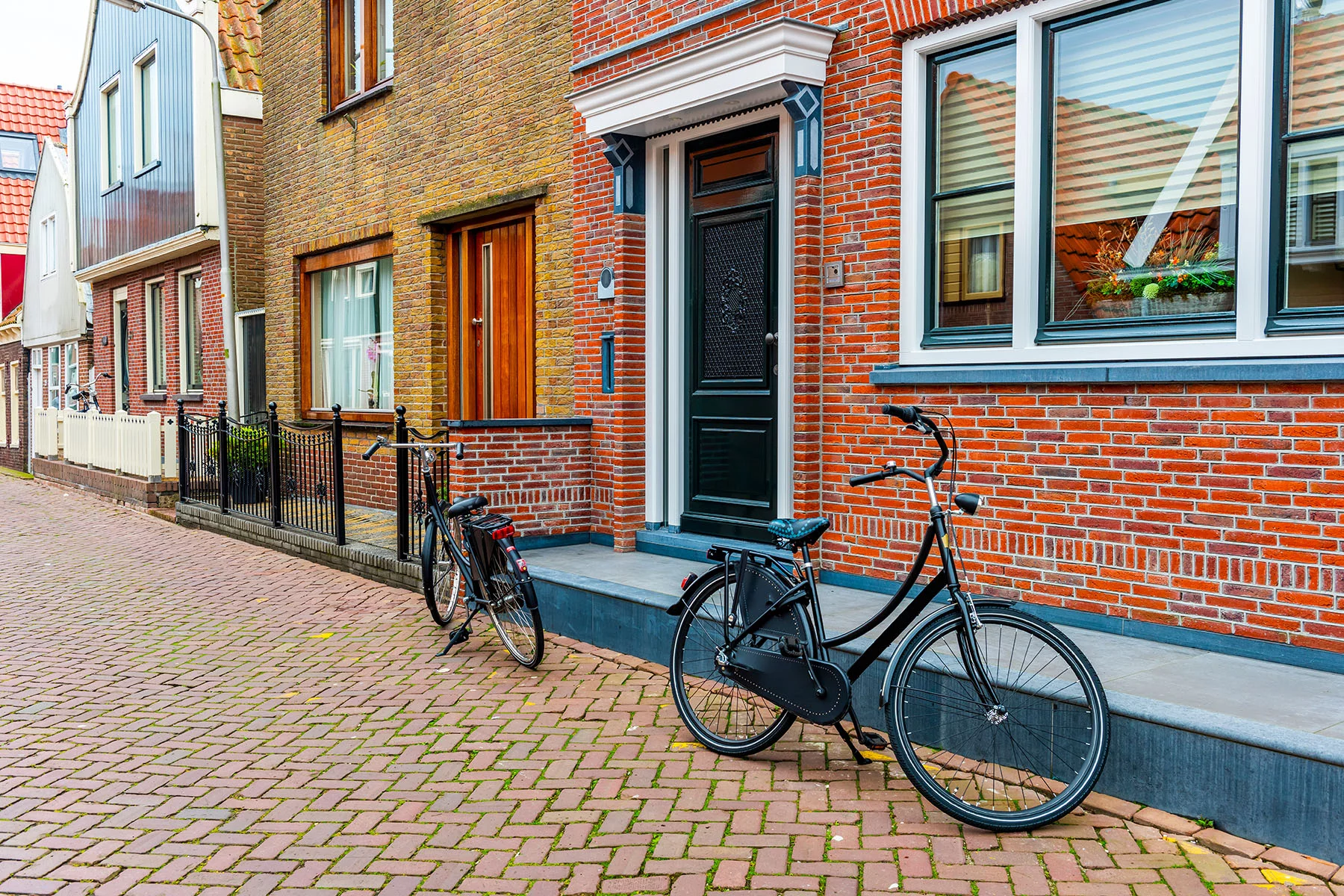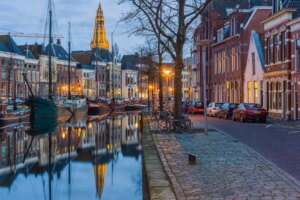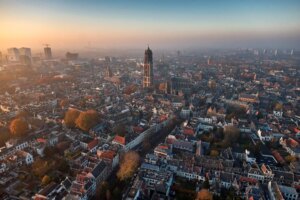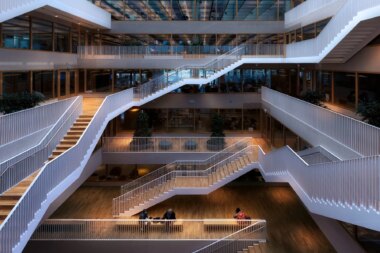Located in the very south of the Netherlands, Maastricht is a melting pot of cultures, bordering Germany and Belgium. This vibrant international community, along with its strategic location, is a major draw for expats.
In Maastricht, you can find important infrastructure like public transportation, flourishing businesses, and historic charm. This medium-sized city is a cultural hotspot with many museums, landmarks, and UNESCO world heritage sights. Maastricht has something for everyone, whether you’re there for work, studying, or a short stay.
For more information, read the following sections:
HousingAnywhere
Simplify finding a home abroad with HousingAnywhere. Their easy-to-use platform lets landlords and tenants connect, offering a popular service for anyone moving internationally. So, find your new home when relocating abroad quickly and easily with HousingAnywhere.
An overview of Maastricht
Bordering Belgium and Germany, in the southern part of the Netherlands you will find Maastricht. This historic and charming city is the capital of the southern province of Limburg. With just over 122,000 residents, about 10% are students. In fact, Maastricht University brings a large number of international students and researchers each year.

The city is also well connected between other European business hubs such as Cologne, Frankfurt, Brussels, and Paris. This makes Maastricht a strategic location for companies and expats looking to expand globally.
If you love walking through historic cobblestoned streets and admiring local culture, Maastricht has it all. Being one of the oldest cities in the Netherlands, means having a unique architecture and many notable landmarks. Its remarkable past is reflected in the scenic historic center and buildings along the Meuse river.
Maastricht’s picturesque squares and charming buildings boast a unique mix of architectural styles including Romanesque, Gothic, Renaissance, and Baroque. You will note influence from the Romans, Franks, Spanish, and French it its unique architecture.
Livability in Maastricht
Maastricht is very livable and accessible, with walking routes and biking paths throughout the city. You will find excellent public transportation, accommodations for people with disabilities, and a high quality of life.
As with any city in the Netherlands, one downside is the cost of living, which is higher than in many European countries. In the Netherlands, you can expect housing, groceries, and extra things like gas or gym memberships to be quite expensive.
Maastricht has a rich history, art, culture, historic buildings, and traditions combined with an international atmosphere, good food, shopping, and international education. You can see why expats are interested in moving to the capital of Limburg.
How to find housing in Maastricht
If you have decided to move to Maastricht, there are many ways to find housing. You can independently search for accommodation or go through a real estate agent.
For student renters, Maastricht Housing is a convenient platform for finding accommodation. Additionally, joining social media groups can also be a useful way to connect with people renting their rooms or apartments in the city.

The Netherlands has many online platforms that landlords and owners use to list properties for sale and for rent in Maastricht, including:
Typical accommodation in Maastricht
While owning is more common than renting in the Netherlands, you’ll find a near-equal number of renters and owners in a city with such a high student population as Maastricht. There will be plenty of houses and apartments for sale in Maastricht, homes for rent, and flatshare opportunities.
In terms of typical accommodation, Maastricht offers plenty of options and diversity. The Netherlands is known for all kinds of housing, from duplexes (twee onder een kap) to townhouses (rijtjeshuis) and apartments (appartement).
If you opt to reside in and around the historic city center (Maastricht Centrum), you’ll likely come across apartments or townhouses with limited or no outdoor space. The buildings, particularly in the historic part of the city, boast a unique charm on the outside, often concealing their modern interiors.
Like most cities in the Netherlands, the housing market in Maastricht can be fiercely competitive. To stay ahead of the game, it’s crucial to give yourself ample time for your housing search, whether you’re looking to rent or buy.
Renting in Maastricht
You may find some similarities when renting in Maastricht compared to other Dutch cities, especially regarding the market’s competitiveness. Apartments are the most common rental properties, especially among students.
Of course, rental prices can vary depending on the size of the accommodation, location, and property condition. For example, if you rent in the city center or southwest area, you will likely spend much more. But, if you settle down in the north-west and south-east neighborhoods, you might get more for your money.

When renting in Maastricht, like other cities in the Netherlands, you can view the apartment and then sign a rental contract (huurcontract) with the landlord or real estate agent. Some landlords may ask for a deposit of two months’ rent and the first month’s rent to secure the property.
Buying in Maastricht
Just over 70% of people in the Netherlands own property rather than rent. Whether you are planning on staying in the Netherlands long-term or looking for an investment opportunity, you may consider buying.
If you’re a newcomer in Maastricht and in need of guidance for your property purchase, you’re in luck. The city offers a wealth of resources, including real estate agents (makelaar) and online platforms like Funda and Woonpleinlimburg, where you can find a diverse range of properties for sale, each with its unique charm and potential.
Plus, mortgage brokers who specialize in helping expats also operate in the Netherlands, such as Expat Mortgages.
Neighborhoods in Maastricht
Maastricht is a smaller sized city divided into seven main districts. Within those macro areas, there are smaller neighborhoods that differ in cost, atmosphere, and available facilities. Neighborhoods are extremely close together, and you can easily cross the entire city by bike. This also means you can live in a more affordable neighborhood but have the city center just a 20-minute bike ride away.
Choosing a neighborhood in Maastricht also depends on what you plan to do in the city. For example, if you come here as a student, you may want to look into staying in Jekerkwartier, which is in the city center and close to most of the campus. Whether you are here for university, work, or raising a family, there is a neighborhood for everyone here in Maastricht.
Binnenstad (City Center)
Located in the most central area of Maastricht, this vibrant, historic, and charming neighborhood is a common choice for expats looking to live at the heart of the city. The Vrijthof Square and the Basilica of Saint Servatius are within walking distance, making Binnenstad a cultural hotspot.
With its array of shops, cafès, and traditional Dutch or international restaurants, Binnenstad is a foodie’s paradise. The picturesque views along the Meuse River provide the perfect backdrop for leisurely strolls and dining experiences. And when the sun sets, the city comes alive with a vibrant nightlife.
Binnenstad is a gorgeous central area known for its convenient leisure activities. You will find numerous supermarkets and pharmacies and have easy access to the rest of Maastricht, including the university. Schools, medical facilities, and parks are just a short walk or bike ride away.

Given the central location of Binnenstad, you can easily bike to any area of Maastricht in a short amount of time. The city also is well connected by bus, provided by Arriva Transport, which operates throughout the Limburg region. There are also a few parking garages around the area, although Maastricht is a low-emission zone, limiting which cars can enter daily.
If you want to stay in the heart of Maastricht’s culture and history while having easy access to all this city offers, Binnenstad might be for you. That being said, this is one of the most expensive neighborhoods in the city.
Jekerkwartier
Still centrally located between Binnensrad and the city walls, you will find Jekerkwartier. This part of Maastricht is home to many of Maastricht University’s buildings, art schools, and parks, making this an excellent choice for students.
Go to the vibrant Market Square for top-tier food, drinks, and shopping. You can also spend an afternoon strolling through the municipal park (stadspark). Its bohemian and artistic atmosphere makes this a picturesque location.
Not only is Jekerkwartier appealing for its quaint and creative atmosphere, but it is also incredibly convenient. With the train station just a 20-minute bus ride away and most of the city’s important areas within a short bike ride, you’ll find everything you need within easy reach. Plus, there are various supermarkets, pharmacies, and medical facilities right at your doorstep.
As this area is university-focused, you will find student libraries, and most of the university’s buildings. More importantly, you’ll find housing that’s slightly more affordable than Binnenstad, making it a practical choice for students. While there aren’t many schools for younger children in the area, they can be easily reached by bike or bus.
Overall, this part of Maastricht is perfect for a student who wants to have convenience combined with a more peaceful atmosphere, but still wants to be close to the heart of the city.
Wyck
On the opposite side of the Meuse River, you can find a charming 19th and 20th-century style part of Maastricht, known as Wyck. Locals might compare this area to Paris because of its architectural similarities.
Not only is Wyck one of the most charming parts of this city, but it is also one of the most convenient, as it is a short bridge away from Binnenstad. Finally, since the central train station is located here, commuters love Wyck.

Wyck is a central area for shopping, especially for local brands and artisanal stores. If you are looking for a unique restaurant scene, Wyck has various traditional, international, and trendy eateries. You will also find numerous events organized by local art galleries or restaurants throughout the year, such as food festivals, seasonal markets, and art exhibitions.
It is no wonder that this is one of the most sought-after neighborhoods in Maastricht, which also makes it one of the most expensive to rent or buy. Nonetheless, this area has fewer schools, parks, and medical facilities, making this a less convenient part of the city for families.
If you want to live in one of the city’s most beautiful and lively areas and are okay with spending a little more on rent, Wyck might be the best choice.
Céramique
Bordering Wyck to the south, but still very central, you will find Céramique. This modern suburb has a central location along the Meuse River. You will also live surrounded by buzzing streets, shops, and cultural hotspots.
Indulge in an afternoon of culture at the Bonnefanten Museum, a unique art museum housed in a strikingly designed building. With its diverse collection of old and contemporary art, it’s a must-see. After your visit, take a leisurely stroll along the Meuse River or head to Binnenstad for a relaxing coffee break.
Living in Céramique means you’re just a short walk or bike ride from the heart of Maastricht. But it’s not just about the city buzz. You’re also close to residential areas with essential amenities like medical facilities, schools, convenient parking, and parks. For instance, the city’s main hospital, Maastricht UMC+, is less than 10 minutes away by public transportation.
This part of Maastricht also has commercial amenities with residential and quiet living options. The neighborhood’s proximity to schools, the city center, and its more affordable rental costs than other central areas make Céramique an ideal choice for families, students, professionals, and more.
Boschstraatkwartier
If you are looking for a central area close to the city center but with lower rental prices, then you might want to settle down in Boschstraatkwartier. The charm of the area with its cobblestoned streets and traditional Dutch architecture, make this neighborhood a unique and vibrant part of the city.
Just north of Binnenstad and along the Meuse, this is a hotspot for students, expats, and professionals. Not only do multiple bus lines run through the area, but it is a short bike or bus ride away from Maastricht University.

The area also has many residential buildings and unique housing options. Not only are there shops, restaurants, and bistros here, but you will find various cultural hotspots. Catch a movie at the Filmtheater Lumière or stroll through Lage Fronten Park. There is something for everyone here.
Families wanting to move here will find a quieter environment with easy access to doctors, schools, and playgrounds. If you are looking to stay in a historic part of Maastricht but still want a residential feel and proximity to Binnenstad, this is the place for you.
Sint Pieter/ Jekerdal / Villapark / Wolder
South of Maastricht Centrum, you will find the city’s largest green space, Sint Pieter, along with the bordering neighborhoods of Jekerdal, Villapark, and Wolder. This is one of the most unique parts of the city.
Sint Pieter was an independent village from Maastricht until they joined in the 1920s. This vast green area includes Fort Sint Peter, St. Pietersburg Hill, multiple ponds, various walking trails, and sights. Also, the area shares a border with Belgium, allowing residents to hop between borders easily on foot, bike, public transportation, or car.
Most of the housing here is outside Fort Sint Pieter, but having such a vast green area nearby makes this an ideal neighborhood for nature lovers, hikers, or families. Various schools, playgrounds, medical facilities, and supermarkets are nearby. As with the rest of Maastricht, public transportation and bike paths are widely available. Therefore, you can get anywhere in the city in a short amount of time.
Since Sint Pieter is further away from the city center, housing prices are also lower. Consider settling down in or near this area if you want a quiet part of the city with peaceful nature and easy access to Binnenstad.
Neighborhoods to avoid in Maastricht
There are not many areas of Maastricht that are considered unsafe. In general, The Netherlands is one of the safest countries in the world. Maastricht, specifically, is one of the country’s safest cities. According to its crime index, it scores an overall 90/100 in terms of feeling safe when walking alone.

Furthermore, the city has a low score of 21 out of 100 for the overall level of crime. As with any city though, there are some areas that residents tend to avoid. You may want to be a bit more careful when visiting Wittevrouwenveld, Blauwdorp, Nazareth and Brusselse Poort.
Tips on choosing a neighborhood in Maastricht
There are so many different parts of Maastricht to choose from with varying amenities, price points, and appeal. To make your search as easy as possible, you can try to follow some tips:
- Research expat groups on social media or other local online groups to ask for advice about living in Maastricht
- Determine your preferences in terms of must-haves and nice-to-haves in order to help you prioritize. For instance, if you don’t have a car, you’ll want to prioritize access to public transportation. Or maybe if you have a dog, you’d want to live near a park. This will allow you to narrow down your options.
- If possible, visit Maastricht before you move there to get a feel for the city and explore some of its neighborhoods
Useful resources
- Expat Centre Maastricht – advice, services and guidance for expats and international organizations
- Gemeente Maastricht – the city council of Maastricht website
- Funda.nl – the top housing search site in the Netherlands











